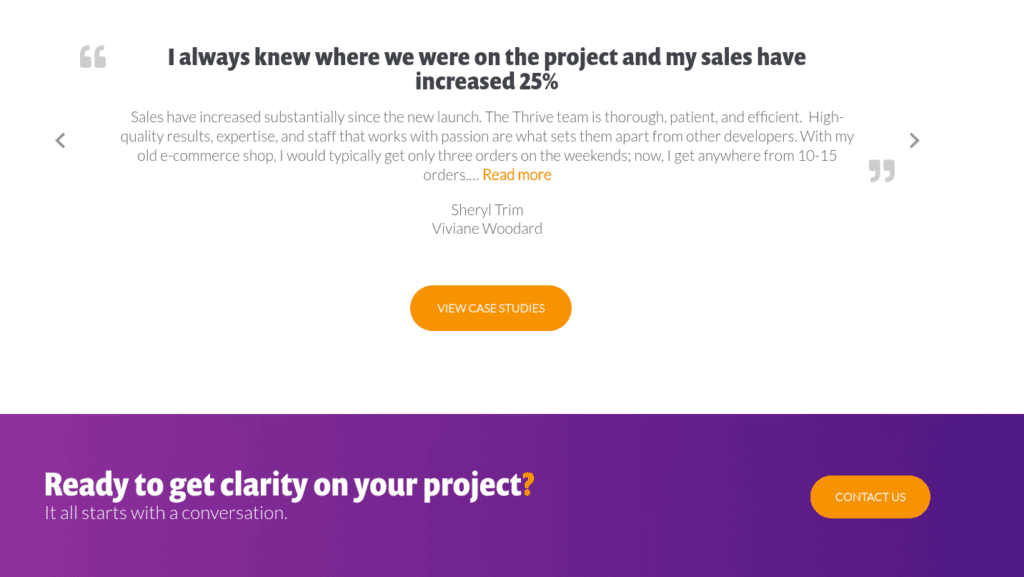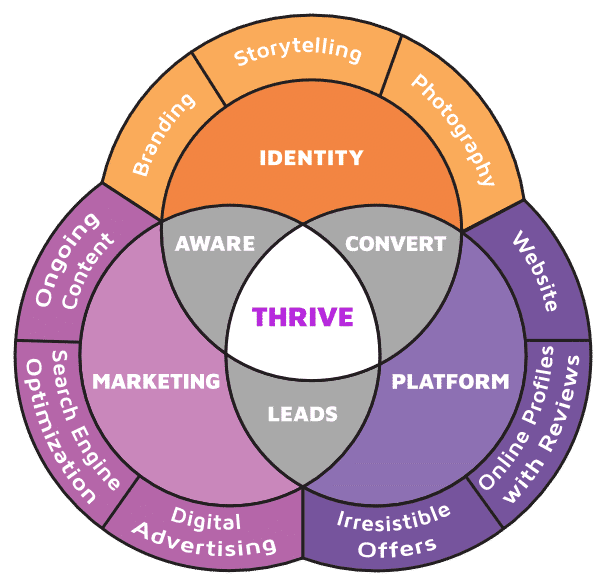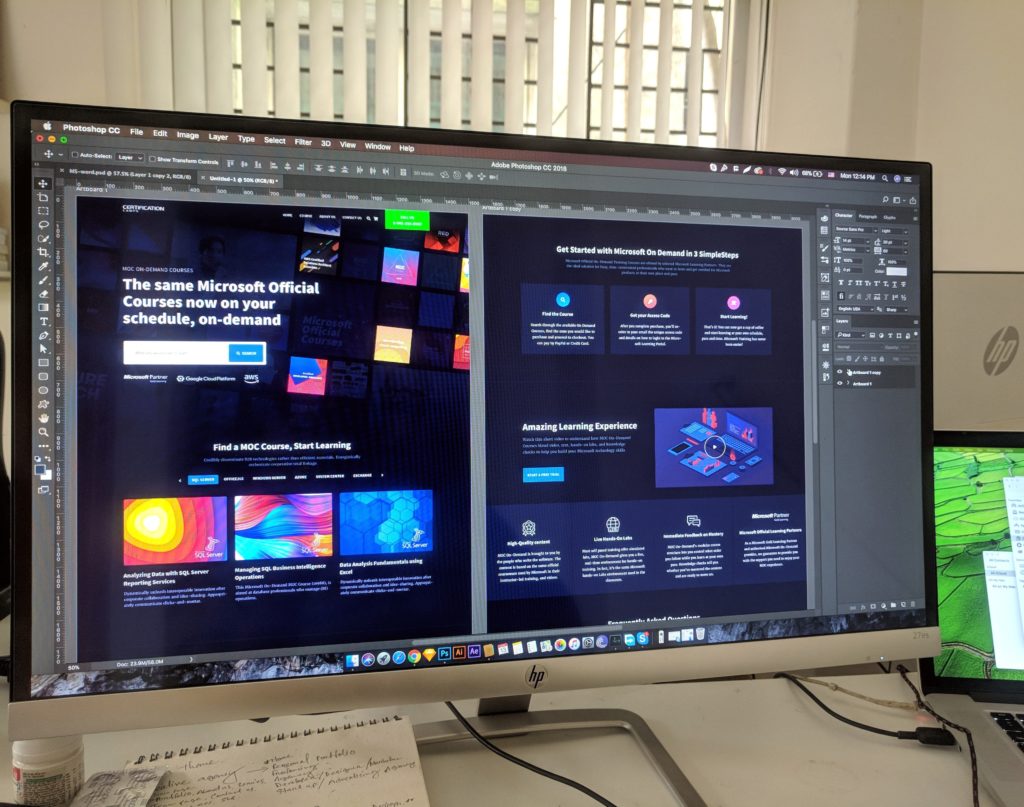At Thrive Design, we believe in quality over quantity. We've focused on assembling a crack team of digital professionals to ensure we deliver outstanding results for every client. With the remote nature of our role, we've been able to go beyond Seattle to find the right people, no matter where they're located.
With that said, it’s an honor to announce that Thrive Design was recognized as one of the 2022 leaders on Clutch’s Top 1000 Global Companies list and one of the top web designers in Seattle, Washington. For context, Clutch is a B2B ratings and reviews platform based in Washington, DC. They evaluate technology service and solutions companies based on the quality of work, thought leadership, and client reviews.
Companies must exhibit an unusually high ability to deliver top-tier work to their clients to qualify for this award. This award is only granted to the highest-performing B2B companies, so we’re incredibly gracious that Clutch has recognized our merit and top-tier work.
“Clutch has been a great source of leads for our agency, and their review/interview process is amazing.” – Noah Britton, CEO, Thrive Design
Words could not express how thankful we are to our clients. Without them, we couldn’t have won this award, and we are incredibly grateful to those who took the time out of their busy day to leave us a review on our Clutch profile. Here’s what they had to say about working with us:
“Our original mistake was hiring a marketing company targeted to our industry. However, they weren’t good web developers. On the other hand, we’re happy with Thrive Design because they know what they’re doing. Their team is great.” – Katherine Dee, Founder, Glow Medispa
Let's chat if you believe in what you do, have a proven offer, and would like to increase your online presence and authority.
As a business owner, you know that marketing is essential to your success. But what if you're not confident in your writing skills? Or maybe you don't have the time to write blog posts or create social media content. That's where professional copywriters come in. Copywriting in Seattle is the art of writing persuasive and interesting copy for both digital and print media. When it's done well, it can improve your marketing significantly.
Here's how.
If you're not a naturally gifted writer or if you simply don't have the time to write all your marketing materials, working with a copywriter can save you precious time. Copywriters are experts at creating compelling content quickly and efficiently. They know how to craft persuasive content that speaks to your target audience and encourages them to take action.
Conversion rates are the number of people who take the desired action on your website, such as subscribing to your email list or buying a product. Professional copywriters know how to write persuasive content that speaks to your target audience and encourages them to take action.
Building trust with your target audience is essential if you want them to do business with you. Copywriters can help you create content that is engaging, honest, and authentic. This will give your audience the confidence they need to trust you with their business.
Working with a professional copywriter can be a wise investment that pays off in the form of increased sales and higher conversion rates. Copywriters can help you create content that is more effective and efficient, which means you'll see a better return on your marketing investment.
When you're ready to take your marketing to the next level, it's time to find a professional copywriter or team. Look for someone who has experience writing for businesses in your industry. You'll also want to make sure they have a strong understanding of digital marketing and SEO.
It's also important to find a copywriter or team that you can trust and who you feel comfortable working with. Be sure to read reviews and testimonials before making your final decision. Once you've found the right fit, you'll be on your way to better marketing in no time!
While working with a professional copywriter is a great way to improve your marketing, there are a few mistakes you'll want to avoid.
Professional copywriting in Seattle can make a world of a difference to your marketing - are you ready?
If you're looking to improve your marketing, working with a professional copywriter is a great place to start. Professional copywriting in Seattle can save you time, improve your conversion rates, help you build trust with your audience, and ultimately improve your marketing ROI.
If you're ready to get started, get in touch with our team today. We'll work with you to understand your business goals and create a custom copywriting strategy that will help you achieve them.
Do you feel like you're stuck in a rut when it comes to your writing? Are you looking for a way to jumpstart your creativity and come up with new ideas?
If you're looking for tips on how to be a better copywriter, you’ve come to the right place. These copywriting secrets are sure to help you get your creative juices flowing and come up with fresh ideas that will engage your readers!
Copywriters are often coming up with new ideas for products, services or campaigns, so it's important to have a list of potential topics to write about. This will help you when you're feeling stuck and need some inspiration.
To get started, try to come up with a list of at least 20 ideas related to your topic. Once you have your list, it's time to start narrowing it down. Copywriting is all about persuasion, so you want to choose a topic that you're passionate about and that you know will resonate with your audience.
Copywriting is all about structure and strategy, so it's important to take the time to plan out your post before you start writing. This will help ensure that your post is well-organized and flows smoothly.
When planning your post, be sure to include an introduction, body paragraphs, and a conclusion. Additionally, you should break down each section into smaller subsections to make it easier to read.
When you're writing copy, it's important to make sure that what you're saying is meaningful and relevant to your audience. Copywriting is not the time to be fluffy or vague. Every word should have a purpose.
Before you start writing, ask yourself if what you're saying is something that your reader will care about. If not, then it's probably best to scrap it and move on to something else.
Copy that is easy on the eyes and visually appealing is more likely to be read and remembered by your readers. When you're planning out your piece, think about ways that you can make it more visually interesting with graphs, charts or images.
If you're stuck on what visuals to use, try looking for inspiration from other sources such as magazines, websites or even advertisements.
When you're writing copy, it's important to use the active voice. This means that the subject of your sentence is doing the verb. For example, "The dog chased the cat" is in active voice whereas "The cat was chased by the dog" is in passive voice. Active voice is more engaging and easier to read, so it's best to use it whenever possible.
Once you have a draft of your blog post, it's important to go back and edit it for grammar mistakes and clarity. Copywriting is all about precision, so be sure to take the time to revise your work until it's perfect.
If you're struggling with editing your own work, try reading it out loud or having someone else read it for you. This will help you catch any errors that you may have missed.
Copywriting is all about getting your point across in a clear and concise manner. When writing your blog post, be sure to use simple language that can be understood by everyone.
Additionally, try to keep your sentences short and to the point. This will help engage your reader and prevent them from losing interest. It's always a good idea to maintain one point per paragraph to make sure your audience can follow along easily and that what you're saying is simple and clear.
Also, try to swap out complex words.
We hope these tips have inspired you to get started on your next copywriting project. Remember, the best way to improve your skills is to practice regularly. So, get out there and start writing!
If you want to create professional and compelling content, get in touch with our team today! Our experienced copywriters can help you take your business to the next level.
What is B2B copywriting, you ask? Today, it's a form of writing used to market products and services to businesses. Copywriters who specialize in this area know how to create persuasive content that can convince potential customers to buy what they're selling.
So, if you're looking to improve your business-to-business marketing efforts, it's important to learn about B2B copywriting and how it can help you achieve your goals. Discover what it is, the benefits it offers, and a few tips for creating successful campaigns.
B-to-B or business-to-business copywriting is the practice of creating marketing materials—such as website content, brochures, email campaigns, and white papers—that are designed to promote products or services to other businesses. This type of writing must be persuasive and able to convince the reader that your product or service is the best solution for their needs. It's important to remember that B-to-B copywriting is not the same as B-to-C or business-to-consumer copywriting; the two require different approaches and strategies.
There are several benefits that come with this type of copywriting for your business. These include:
Increased ROI: Copywriting is an effective way to increase your return on investment (ROI). A well-written piece can persuade a reader to take action, whether that's making a purchase, signing up for a service, or requesting more information.
Improved brand awareness: When done well, it can help you improve brand awareness and position your company as an expert in your industry. By creating compelling content that educates readers about your products or services, you'll be able to build trust and credibility with potential customers.
More qualified leads: It can also help you generate more qualified leads. By targeting businesses that are likely to be interested in what you have to offer, you can save time and money on marketing efforts.
Now that we've covered what B2B copywriting is and the benefits it offers, let's discuss a few strategies for creating successful campaigns.
Research your audience: It's important to know who you're writing for before you start crafting your message. Take some time to research the businesses you're targeting and learn about their needs and pain points. This information will be helpful when it comes time to create your content.
Keep it simple: When you're writing for a business audience, it's important to keep your language clear and concise. Use short sentences and straightforward words to get your point across quickly and effectively.
Focus on the benefits: Remember that businesses are always looking for ways to improve their bottom line. When creating your content, focus on how your product or service can help them achieve their goals.
Now that we've covered the basics of B-to-B copywriting, let's take a look at some examples.
Example 1
The headline: Need to increase sales? We can help!
The body copy: At Thrive Design, we specialize in creating marketing campaigns that generate results. Our team of experienced copywriters can help you create content that's designed to increase sales and improve ROI. Contact us today to learn more.
Example 2
The headline: Looking for a way to stand out from the competition?
The body copy: Copywriting is an effective way to position your business as an expert in your industry. By creating compelling content that educates readers about your products or services, you'll be able to build trust and credibility with potential customers. Contact Thrive Design today to learn more about how we can help you create successful marketing campaigns.
Example 3
The headline: Need help generating leads? We can assist!
The body copy: Copywriting can also be used to generate more qualified leads. By targeting businesses that are likely to be interested in what you have to offer, you can save time and money on marketing efforts. Contact us today to learn more about how we can help you create successful marketing campaigns.
Now that you know a little bit more about what B to B copywriting is, as well as the benefits it can offer your business, it's time to start thinking about how you can incorporate it into your own marketing efforts.
If you're not sure where to begin, Thrive Design team of experienced copywriters can help. We specialize in creating custom content that resonates with your target audience and drives results. Contact us today to learn more about what we do!
Copywriting and content writing are two terms that are often confused - many people believe that they are the same thing. Today, it’s important to understand the differences between the two before you start creating content for your website.
Below, we explore the differences between copywriting and content writing and outline tips on how you can use both techniques to create powerful and effective content for your business!
Copywriting is the art of persuasion. It is the process of creating persuasive and compelling content that can convince your readers to take a specific action. For example, if you are selling a product, your goal as a copywriter would be to create content that persuades your readers to buy that product.
Examples include advertising copy, brochure and catalog copy, website content, direct mail, sales letters, email marketing messages, press releases, white papers, and blog posts, among others.
Content writing, on the other hand, is all about providing information. It is about creating helpful and informative content that educates your readers and helps them make better decisions. When it comes to content writing, your goal is not to sell anything. Instead, you want to provide value and help your readers in some way.
Examples of content writing include articles, web page content, social media posts, E-books, and more - ultimately, it really depends on the purpose behind your writing.
The main difference between copywriting and content writing is the purpose of the content. Copywriting is all about persuasion and selling, while content writing is about education and providing value.
Another difference between these two types of writing is the tone. Copywriting is typically more aggressive and sales-oriented, while content writing is usually more relaxed and informative.
Finally, copywriting is generally shorter and more to the point than content writing. This is because you only have a limited amount of time to persuade your reader to take action. On the other hand, content writing can be longer because you have more time to provide valuable information to your readers.
The answer to this question depends on your goals. If you want to sell something, then you will need to work with a copywriter. However, if you want to provide value and help your readers, then content writing is the way to go.
Of course, you can also use both techniques in your content. For example, you could start with a piece of helpful and informative content that educates your readers. Then, at the end of the article, you could include a call-to-action that persuades your readers to take a specific action.
Both copywriting and content writing are powerful tools that you can use to create effective and engaging content for your business. So, now that you understand the difference between these two types of writing, it’s time to start creating some great content for your business!
If you want to create effective and engaging content for your website, then you should use both copywriting and content writing.
Here are a few tips on how you can use both techniques to create powerful and compelling content for your website:
Start with a catchy headline: Your headline is the first thing that people will see, so it’s important to make it count - a great headline will grab attention and make people want to read more.
Use persuasive language: When you’re using copywriting techniques, be sure to use persuasive language that can convince your readers to take action.
Make it easy to read: Use short sentences and simple words. No one wants to read a wall of text, so make sure your content is easy to read and digest.
Include a call-to-action: Always include a call-to-action at the end of your content. This will encourage your readers to take the next step, whether it’s signing up for your newsletter or buying a product.
Both copywriting and content writing are important tools that you can use to create effective content for your business website. Use these tips to start creating great content that will engage and persuade your readers!
If you're looking for professional copywriting expertise, on the other hand, get in touch with us today. At Thrive Design, our team of experienced writers can create compelling content that will help you achieve your business goals - in style and on time.
As a business owner, it's tempting to think that you can do it all. You formulated and built your business from the ground up and it's doing well -- why shouldn't you also be the one to write all the materials your business needs to interact with customers?
Well, for one, you're probably not doing it well. It can be hard to let go of a part of your business that seems so integral to finding and maintaining a strong customer base. So let us show you why hiring a freelance copywriter to craft your written content is a great investment and why you shouldn't be spending your time on copywriting.
A professional copywriter is just that: a professional. Contrary to what many think, copywriting is not a skill that you can pick up and put down just when you need it. Good freelance copywriters have spent years honing their craft. They know what kind of content is needed in specific situations and how to craft content that not only gets your information across but also resonates with your audience.
Ask yourself. If you have a large plumbing job in your home, are you going to shrug and start attacking it yourself or are you going to hire a professional who can get better results in a shorter time?

Be honest. How much time do you currently spend writing content for your business? By hiring a professional writer, you get all of that time back to spend with a client or on other tasks you'd rather be doing.
Remember, you need to be creating consistent, engaging content on a regular basis in order to keep a stream of prospective clients and customers coming to your digital front door. A professional writer or freelance copywriter can create this kind of content in a fraction of the time it will take you.

You know your business better than anyone else out there but that doesn't make you the best person to tell the world about your business.
Stay with me for a minute.
You are responsible for the daily operations of your business. You know it in, out, and backward. However, being an expert in your field does not mean you are an expert at marketing your services and expertise.
What can happen when a business owner writes the content for their business is that the content starts to focus on JUST telling the business's story. It's business-focused content.
What a new client needs when they hit your website is content that's customer-focused. They need content that talks to THEM about THEIR needs. Copywriting that speaks to this is much more likely to sell your products and services.
Related Reading: How to Write Calls to Action that Really Work

If grammar, spelling, and punctuation aren't in your skillset, don't fret. The proliferation of lists cataloging these kinds of mistakes on professional websites shows that you are definitely not the only one out there.
However, your potential customers, not to mention Google, will judge your business unfairly if there are more than a few of these mistakes in your content. It makes you look unprofessional and does not instill a sense of confidence in your audience.

An experienced copywriter can make anything sound exciting. And I mean anything. Have you ever wondered how house painters, roofers, HVAC repair companies, or soap companies can keep up a stream of regular content that ranks well? Two words: quality content.
A freelance writer will not only familiarize themselves with your business and field, but they will also find ways to engage potential clients with interesting and relevant content that speaks directly to your target market, building your reputation and driving sales.
Related Reading: One Easy Way to Convert Visitors Into Customers

How many types of content does your business need to be successful? A product description? A blog post? Sales funnels full of content? Social media content? A white paper from an expert?
You may be great at creating one of these kinds of content but how are you at all of them? Copywriters understand the importance of variety and have the copywriting skill to create anything you need. A well-rounded, strong writer will be able to create everything you need, saving you time and money.

Copywriting is sometimes the last thing that comes to mind when you're getting ready to launch a new product or service. You've spent a lot of time creating and honing this new offering and maybe left the marketing of it until the last minute.
Or maybe you've decided to invest in Facebook ads or a Google AdWords campaign and want valuable content you know will be powerful to make the investment worth it.
Whatever your situation, sometimes you just need professional copy. Investing in copywriting services can make the difference between success and failure.
Copywriting is one of the nine (9) key areas we focus on in our Blueprint for Online Excellence. When visitors land on your website or your social media channels, the words they see must capture their attention and not let it go. Capturing their attention once they are on your online property is the first step to completing a sale or earning a new customer and that's where professional copywriting services come in.
So I have to ask: Does the copy on your website inspire your potential customers to stick around and get to know you better or does it have them heading for the exits? If your answered the latter, contact Thrive Design today.
You've seen them before. You've probably even clicked on more than a few. But you may not have known that they are a proven marketing tactic that can dramatically increase your conversion rate.
They're called "calls to action" and they are what directs your visitors to take a specific action that you want them to take.

Let's start at the beginning. You've invested money in a marketing campaign designed to accomplish a certain goal: increased sales, increased website visits, increased downloads, or promoting specific products.
You know what the goal of your marketing campaign is, but will users know what to do once they've encountered your marketing pieces? That's where calls to action come into play.
A call to action (CTA) is a short, simple phrase that directs your website visitors to take specific actions that will move them along your sales funnel. It can be just a few words ("Download Now") or a few sentences ("Want to learn more? Download our free guide today!"). It can be a pop-up, a link, or a button.
A good CTA will encourage specific actions based on where the user is on your site and what content they've been interacting with. For example, a "Contact Us" CTA would be out of place and not as persuasive on a landing page for a downloadable piece of content. A "Download Now" action button would be much more relevant to the goal of the page.
Featured Reading: One Easy Way to Convert Visitors into Customers

You will see calls to action anywhere that a company knows people are paying attention. Specific web analytics can show you where your users are looking on your webpage. This allows companies to put CTA buttons anywhere they know their users are looking.
This is the most common place you will see a CTA. A well-designed CTA will stand out from the rest of the page so you are drawn to it and, therefore, more likely to take action. These action buttons should be easy to click no matter what device your visitors are using.
If you're going to interrupt a potential customer's browsing experience with a pop-up CTA, you have to make it worth their while. It should be short. It should be persuasive. And it should be something they will value.
We know that web users don't read all the content they're presented with. They skim. So when you are designing a pop-up CTA button, you need to make the value of clicking immediately stand out. These are great options for sales or free downloads because the value is immediately clear.
In-text CTAs are more subtle than CTA buttons that are used on web pages or in pop-ups. You can see them on this page. They're the links set apart with horizontal lines and the CTA "Read more."
These in-text links are a great way to improve your visitors' user experience. They can point them to related posts, more information about related products, lead generation downloads that are related, or to follow you on social media. All of these actions will bring them further into your sales pipeline, as well as building your reputation as a subject matter expert.
That's not to say that your blog posts should only have in-text CTAs. Blogs are valuable CTA real estate especially for the most valuable CTAs: those that ask people to buy your product or service. These CTAs should be placed at either the top or the bottom of the post as these are the places where people are paying the most attention. You can do some simple A/B testing to find out which placement is most lucrative for your business.
Just like in-text calls to action or CTA buttons on your website, you can effectively use calls to action in your email marketing as well. Whenever you ask your readers to "read the full article," "download now," "take advantage of XX," or "click here to get more information," you're using a call to action.
With email CTAs, it's important to make it stand out. Inboxes are overcrowded and you are pushing out information to your customers, rather than having them come to you through search or a direct click. When you make your links bold or set them apart in an attractive button is key to getting that all-important click.
Strong CTAs are crucial to a successful social media strategy. The social media landscape is crowded. There are so many other posts, videos, and links competing for attention that you need to be incredibly clear about the action you want users to take.
A compelling CTA will grab your audience's attention and make them focus on your offer. The actions you want them to take should be clear and easy for them to accomplish. Users on social media are more likely to follow a CTA that is simple like "click here" or "read more" than they are "fill out this form."
If you are looking for some imagery to help your social media engagement, PikWizard holds a stunning library of over 1 million stock images and videos. These are royalty free and safe for commercial use, with no attribution required.
Featured Reading: 5 reasons you need a professional copywriter: step 2 of 9 for dominating online

Now that we've covered what CTAs are and where you are likely to find CTA buttons, let's dive into the meat of this article: how to write a killer CTA that will increase conversions and help conversion rate optimization.
First thing first. You don't want just any CTA. Throwing a generic "Download now!" link without any context isn't going to significantly help your conversion rate. You want a tailored, strong CTA that will resonate with your visitors and move them to act.
You need to not only tell people what to do but also why they should do it. It's the why that's going to help you increase sales, downloads, submitted contact forms, or whatever your goal for the page happens to be,
An essential part of this tip is including specific action phrases in your calls to action. It may be tempting to use something cute and crafty but action verbs are what propel the reader to actually take the action that will result in more conversions.
Using the first or second person tense makes your CTA much more conversational like you're talking to a friend. Addressing your visitors like they're already a customer, a part of your company's family is a great way to encourage them to take the actions you want them to take.
For example, which one are you more likely to click:
Small businesses need a strong web presence. Download this free guide to find out how Thrive helps them grow.
Or
You need a strong web presence. Download this free guide to find out how Thrive can help you grow.
The odds of your audience taking the action you want them to take once they have left your page plummet to close to zero. Let's be honest. Very few people will put "Join (company's) email list" on their to-do list and come back to your website to give you their email address.
Without a sense of urgency, your audience will have all the right thoughts and intentions of signing up, downloading, contacting you now but won't in the end.
However, creating a sense of urgency doesn't necessarily mean inspiring panic. Offering time-sensitive deals and discounts, a referral incentive, or a sign-up bonus can be a friendly way to create a little urgency on the part of your customers.
The more steps you ask your visitors to take to complete the actions you are asking them to complete, the more likely they are to drop out of the process before finishing. If you want them to provide their email address to download a PDF guide or list, don't make them click more than twice or provide more information than the bare minimum.
When you click on our "Download now!" button to the right, we ask for your first name and email and BAM! you're done. You get our free guide in your email almost immediately for less than 30 seconds of your time. Our guides wouldn't convert half as well if, for example, this button redirected you to a landing page where you had to scroll to the bottom to get to another download button and then have to put in your information and click a third time.
We want people who want our guides to not have minutes to think really hard about if they really need that information. (They do need the information but the longer we make them wait, the less they want it.)
You'll read a lot about how simple web design is better and the importance of keeping your pages clutter-free. (We've even written about that topic.) But the exception to this is with your CTA buttons. You want these to be bold and stand out from the rest of your design.
Use a bright color. Put it in the middle of the page or wherever the eye is drawn to first. Give it some context so readers know what to do with it and why it's going to help them.
Do you know why people are coming to your website? (If you don't, you really should.) The best way to get people to click on your CTA button is to demonstrate how doing so will solve (or help to solve) the problem they need help with.
One of my favorite rules in business and in life is KISS (keep it simple, seriously). When we overcomplicate things, it throws up unnecessary roadblocks to action. The same comes with the language we use.
In 99% of cases, the simplest way to say something is the best way. Cheeky or flowery language may go viral or be used in most "best of" lists, but the odds that you'll be able to replicate that success are low. It's much better to be simple and straightforward so we're guaranteed to quickly and effectively communicate with users.
Featured Reading: The Irresistible Freebie: Step 6 of 9 for Dominating Online

Distilling everything we've talked about in the previous sections, let's take a look at some proven phrases that punctuate successful calls to action. Remember, context is important and it's up to you to provide a simple "why" for your users. These phrases are examples of the action part of "call to action."
The best advice I could give when asked "how do I get more visitors to convert to customers" is "ask them to." That's it. It's simple. When you are providing a valuable service that your visitors are interested in, all they need to take the next step is a prompt from you.
Now, this assumes that you have solid content and information they will find valuable in helping them solve a problem and that your website is optimized and easy to use for visitors. Once you have the building blocks in place for a strong web presence, it's time to add some powerful calls to action to your site and marketing materials.
What has been a call to action that was particularly successful for you?
—
Thrive Design is a customer-centric web design and marketing company from Seattle. Contact us today to find out how we can elevate your business online! Find us on Clutch, UpCity, LinkedIn, Facebook, and Twitter.
We talk to our clients a lot about the importance of creating sticky websites. A sticky website is one that keeps people around longer than other sites. When people stick around, the odds of converting them from a visitor into a customer increase.
Sticky websites also rank better across search engines. If your website is sticky, your "average time on page" statistics are better which signals to Google and other search engines that users find your website a valuable source of information.
So how do you create a website that keeps customers around? First, you need to understand what turns them away.

Your potential customers are looking for websites that add value to their lives. They are inundated by ads throughout their online lives and do not want to visit websites that are just glorified billboards. If they are unable to answer the question "What's in it for me?" within the first 15-30 seconds after landing on your site, they'll leave and your bounce rate will skyrocket.
The other reason that users will leave your site prematurely is fairly simple: trust. Creating a website is deceptively easy and, really, anyone can do it. That means that there are a lot of untrustworthy sites, including ones made by bad actors.
Luckily, many users have unknowingly become fairly sophisticated at analyzing the trustworthiness of a website. They are applying these principles to analyzing your website as well. They're looking for two things.
By focusing on adding elements that boost perceptions in the first category and limiting elements that boost perceptions in the second category, you enhance the likelihood of capturing people's attention long enough to employ other strategies designed to keep potential customers around.

Now that we've covered why people leave your site, let's talk about how you can encourage them to stay around.
Clickbait has a terrible reputation for a reason: people hate being promised one thing and then given another. Your blog posts and landing pages need to fulfill the promise set by the headline if you want people to stick around longer than a few seconds.
Fun fact: users spend an average of fewer than six seconds looking at your website's content. That doesn't mean they aren't getting any use out of it. It just means that they are reading your website in a different way than they read, say, a book.
Website visitors scan your content to get what they need in the least amount of time. If you create content designed with this reading behavior in mind, users will return to your website time and again to get what they need.
Engaging and informative subheadings, as well as shorter paragraphs (two to three sentences), are key to creating a scannable piece of content, even in your long-form content. Lists and infographics are also great options for easy-to-scan content.
Keep Reading: 5 Reasons You Need a Professional Copywriter: Step 2 of 9 for Dominating Online
Even the most well-written posts will leave visitors cold if there's nothing in there that directs them on what to do next. The best time to ask them to take action is right after they've finished reading a blog post. Don't be afraid of direct calls-to-action (CTAs). These CTAs add value to the user experience and increase the time spent on your site.
Another way to direct readers to other content of value is to insert internal links to related content throughout your content as a way to direct traffic through your site. (Ever started reading a particularly valuable article and clicking on every link in it to read more? That's the kind of content direction we're talking about.)
Whenever you have an opportunity to keep traffic on your website, you need to take it. This is especially true with your landing and thank you pages. Users that have landed on these pages have taken an action that shows they are interested in your product or business and want to learn more.
Instead of leaving that lead cold, why not present them with related, useful content on your site that keeps the reader engaged longer.
Guest blogging is a win/win arrangement. When you host guest bloggers on your site, you're inviting a brand new audience to your website as well as taking a little bit of content creation off of your plate. Just be sure that you only post high-quality, original posts without spammy links. Google is cracking way down on low-quality guest blogging.
Similarly, when you guest blog on other sites, you're able to build credible and trustworthy backlinks to your site. These backlinks are a key part of your search engine optimization strategy.
LinkedIn has become the most valuable B2B social media site out there. If you have a moderate to large following on that platform, it can be incredibly valuable to start posting content there to start directing traffic back to your own website. This will also serve to raise your profile in your industry and build trust.
Keep Reading: 12 Effective Digital Marketing Strategies in 2020 and Beyond
Have you nailed your high-intent and popular keyword bases in your SEO strategy? If so, it's time to start investigating the best long-tail keywords to begin targeting. Long-tail keywords are more like search phrases than search words and it's the future of search.
Long-tail keywords now account for the majority of web searches. People are no longer searching for "wallpaper removal." They're searching for "best ways to remove wallpaper." It's time to start incorporating these in your paid SEO strategies.

Content aside, there are many things you can do to make your website a pleasant experience for your visitors. People like to hang out on websites that are welcoming and easy to use. These easy to implement formatting tips will help keep your bounce rate low.
A sticky website is one that benefits both your potential customers and your business. A sticky website works hard to keep your visitors around long enough that they become warm leads and then, eventually, customers. A sticky website is the strongest tool in your digital arsenal.
So, you have to ask yourself: How sticky is your website?
—
Thrive Design is a customer-centric web design and marketing company from Seattle. Contact us today to find out how we can elevate your business online! Find us on Clutch, UpCity, LinkedIn, Facebook, and Twitter.
When visitors land on your website or your social media channels, your words need to capture their attention and not let it go. Copywriting and storytelling are the keys to engaging your audience in meaningful ways that can convert visitors into lifelong customers.
Your story is unique to your business. It’s a big thing that separates you from your competitors, and it’s a great way to relate to your customers. Copywriting and storytelling are how you can compellingly tell your story and weave that story into every aspect of your marketing. To have the impact you want, your content needs to sing.

You see copywriting everywhere. It’s on all the advertising you see. It’s in all of the emails your receive from your favorite experts, companies, and brands. It’s in your favorite how-to guides, blog posts, and podcasts.
Whether you realize it or not, your business already engages in copywriting. All of the text on your website? Copywriting. Your social media channels? Copywriting. The scripts you give your salespeople? Copywriting. Emails you send, fliers you make, advertising you buy? Copywriting.
Sometimes, quality copywriting is what differentiates you from your competition. Poor copywriting can leave potential customers confused about how your product or service can help them with the problem they are trying to solve. It can leave potential customers feeling disengaged or not connected with your business. It can even make them think they are not your target audience.
Good copywriting, on the other hand, will make your brand stand out among the competition. Good copywriting welcomes your target audience through the language and tone used, as well the specific words chosen. Consistently used, good copywriting can give your brand a unique voice in your industry.
By having a recognizable brand voice, you give your customers something to identify with and remember you by. Customers that know your brand, understand your product, and remember your voice are much more likely to become repeat customers and recommend you to others.

Content marketing has become the go-to strategy for businesses looking to dominate online. Well-written copy that is appropriately targeted to your audience will show them the power of your product or service in solving their problems. It can convince them of the superiority of your product or service to that of your competitors.
Investment in a content marketing strategy based on good copywriting can have many benefits for your business.
72% of online marketers say that content creation is their number one SEO tactic. Google agrees. It penalizes websites with poor content by ranking them lower than sites with higher quality content. Google knows this through monitoring the bounce rate, page depth, and time spent on the site
Professional copywriters know how to target the keywords you’ve identified as bringing in the most traffic. They can weave those into your copy naturally, a strategy loved by both users and search engines alike. They know how to write powerful calls to action and how to place links that encourage users to click through.
Bottom line, they know how to create webpages and blog posts that rank well.
Have you ever spent time on a page that was hard to read? Whether it’s confusing, uses language that doesn’t resonate with you, or is just poorly written, if you’ve come across a webpage like this, you probably didn’t spend much time on it.
A well-written website, landing page, or email is a much more enjoyable experience for your audience. They may even find some pleasure in reading through your content when it’s well written. It will keep them more engaged and more motivated to do business with you.
The bottom line is that good copy can increase your bottom line. Powerful calls-to-action and copy explaining the benefits and advantages of your product or service can motivate potential customers to take that next step to become paying customers. Unless properly motivated, it’s easy for visitors to leave your website thinking they should make a purchase but not taking that all-important final step: making a purchase.
Are you in a crowded industry or one where your product or service is complicated? Are you selling something new or unique that people are unfamiliar with? If so, you need copy that powerfully sells your customer on the benefit of using YOUR product or service and why your potential customers need it.
Good copy can persuade potential customers that are on the fence about the benefits of working with you and purchasing your product or service.
We are inundated with words every day. From our scrolling through social media to overwhelmed inboxes, to advertisements in between it all, we see more than our fair share of things to read throughout the day. When you want to stand out from the crowd and actually be remembered, it’s time to invest in good copywriting.
Good copy evokes emotion. It is not just about constructing sentences in English and posting them. It taps into your audiences’ feelings and emotions and leaves them with the knowledge that you, your product, or your service can help make their lives better and easier. By going beyond the intellectual and tapping into the emotional, your message automatically becomes more memorable.

People visiting your website are looking for you to be the expert they need. They’re looking for help solving a problem from someone who is knowledgeable and has experience with their particular problem.
They are not looking for someone who may know everything about, say, painting but can’t be bothered to proofread their website. There’s something about typos, misspellings, and hard to read sentences that turn people off. It takes away from your authority, even if you are the best painter in town.
Good copywriters can help ensure that your website is error-free, easy to read, and engaging.
Even if you have impeccable grammar and a firm understanding of how to write to engage people, that’s not why you got into the painting business, to continue with this analogy. You got in it because you love to paint houses.
However, the internet is not going anywhere and the fact remains that you need to produce new content regularly to maintain and improve your search engine standings. Businesses that blogged daily earn 82% more customers than those that don’t.
Blogging daily isn’t sustainable or feasible for most businesses as the quality of content is as important as the frequency. But this stat goes to show that creating new content is important for earning new customers.
Good copywriters can help populate your website with fresh content regularly. The best copywriters can do it in a way that your customers never know it’s not you writing the content.
Whether you hire a copywriter or tackle the job yourself, it’s important to understand how vital good content is to your business. As you move on to the next steps of our Blueprint for Online Excellence, it’s all balancing on the foundation built by your website’s content.
You want as sturdy a foundation as possible. You want a foundation that shows your target audience you are a business they can trust. Any digital marketing strategy you implement needs to be based on effective content. Effective content is dependant on effective copywriting.
Effective copywriting? Well, for that it's not a bad idea to invest in a professional copywriter.

—
Thrive Design is a customer-centric web design and marketing company from Seattle. Contact us today to find out how we can elevate your business online! Find us on Clutch, UpCity, LinkedIn, Facebook, and Twitter.
Once you’ve dialed in your SEO, perfected your pay-per-click ads, and ensured your website has a user-interface that your customers will love, how do you get those shiny, new visitors to take the next step to become customers or clients?
Solid, catchy, compelling content.
Copywriting is one of the keys to your website’s success. You want content that persuades and convinces easily, not that is stilted and hard to read. You want your content strategy to be supported by quality content.
The tips here will help you create content for your website, marketing materials, emails, and more that converts people to customers and customers to raving fans.

Writing is something you either love or hate. If you're in the latter category, these steps and tips will help you make the most compelling content you can in the least amount of time. (If you really hate it, check out our new copywriting services and let us take care of it.) If you're in the former category, you will definitely find some tips in here that will help you take your writing from 10 to 11.
The first thing you need to master is the art of the headline. You need to be able to grab people’s attention with a headline that speaks to the problem you are trying to solve. However, even for professional writers, headline writing can be a tricky art.
You want a headline that is short and sweet but also packed with words that are powerful and stir emotions. You want a good mix of words people are used to seeing and unique words that will catch their attention and hold their interest. And you need it to speak to the actual content you are creating.
Sound tricky? It is. Luckily, there are some great, free headline analyzers out there that will give you an overall score for your headline and give you tips to improve it. I like the one from coschedule. It’s definitely worth the email sign up.
(In case you were wondering, this headline got a score of 68. Not the best, but definitely not the worst.)
Do you know what doesn’t motivate your readers? Reason. Reason can convince them that it’s a good idea to do something but it doesn’t actually get them to click the “buy” button. It probably won’t even get them to click the “schedule a consult” button.
To get your potential customers to take action, you need to get them to feel something about you and your product. You need to get them excited about the possibilities or worried about missing out or scared that their competitors will get an advantage.
All of these emotions will help convert intention to action. Of course, you need to lay out the best case for using your product or service. You shouldn’t ignore reason all together when writing. But you also shouldn’t shy away from using emotion to get your customers to take action.

Do you know why Black Friday became a huge sales driver for stores? Do you know why Amazon has made Prime Day it’s own sort of holiday? Do you know why you check the “Clearance” rack whenever you visit your favorite store?
Because all of these deals are short-lived. Black Friday deals only last a little while. Prime Day deals have an actual countdown clock on the product page so you know exactly how much time you have left to snag that item. Items on the clearance rack are gone, never to return, once they’re sold.
Retailers get you to buy more than you intended to by convincing you that there won’t be a better deal later and that you need to buy NOW in order to save big. But, really, that TV will probably go on sale again. That Prime Day deal may not be the best one available, even though it has a countdown clock. (True story, I snagged a Prime Day item cheaper on the non-Prime Day item listing the first year Prime Day was introduced.)
If your content can instill a sense of urgency in your readers, they are more likely to take the action you want them to take.
Featured Reading: Top 10 Things Every Website Needs.
Ok, this step is tricky. For SEO purposes, having a good amount of long-form content on your site, specifically your blog, is a best practice. However, what you want to avoid is having long blocks of content that are hard for readers to, well, read.
Unless it’s a subject they are truly interested in, most people will scan content for the information they need. It’s even better if they can scan headings that direct them to the information that will be most valuable to them.
As you can see, I practice what I preach. I keep all paragraphs to no more than three sentences. (Four is ok if they are short.)
I break up my content with clear, descriptive headings that you can quickly grasp and either move on or read more if you want more information. That way, I can produce long-form content that brings in readers while making that content easy to digest and more likely to be actually read.
This same content strategy can be used throughout your business website. Break up product descriptions with headings. Use headings when you are describing your company on the “About Us” page or your process.
You won’t go wrong when you make your content easier for your audience to scan.

One mistake that many websites make is assuming the audience knows what to do once they’ve finished reading their content.
Spoiler alert, they probably don’t.
Most visitors to your website are looking for directions. They want to be told HOW to solve the problem they are facing. They need you, through your content, to tell them WHAT to do next in order to solve it.
That’s where your call to action comes in. Your content needs a call to action that’s clear and unmistakable. It needs to be prominent and hard to miss. The content's call to action should also be simple to accomplish.
A great call to action is short, sweet, to the point: Buy today for clearer skin tomorrow!
A poor call to action buries the actual action: When you invest in this skincare line, you are investing in better skin for life.
See the difference? Both talk about buying a skincare product but one gives a sense of urgency and is explicit in what you need to do to solve your skincare problem. The other one talks around the act of purchasing and doesn’t actually tell the reader what to do, just what will happen if they take the action.
This is where your content strategy comes into play. Your content strategy should be based on thorough research and supported by data about your audience.
You are looking to solve a problem for your audience through your product or service, right? The best way to get the people who need help with that specific problem to view you as a trustworthy purveyor of the solution is to give them content that helps them solve the problem your business solves.
Here’s an example. Right now, there are two blog posts on my site that are bringing in loads of traffic and are scoring great on search engines. But it’s doing me no good.
Why? Because the two blog posts are about free UX design courses and the best fonts to use for online readability.
I do not offer UX design courses and I’m not looking for customers who are interested in the readability scores of fonts because I worry about that for my clients. So as popular as these blogs are, I’m not super thrilled because the traffic they’re bringing in aren’t my people.
My people are people who know their site can do better and be better and need someone to help them along the way. My people are worried about things like how to convert readers into customers, not how to become a better UX designer.
Featured Reading: Why Professional Photography and Copy Convert Website Visitors into Paying Customers

To create content that truly converts, you need to eliminate distractions that are unrelated to the goal you are trying to achieve.
That lead generation download prompt on your sidebar? Try and ensure they are to lead gen content that’s related to the on-page content.
In-text links to other material? Make sure that the link is to content that is on-topic or expands on the topic at hand.
Everything on the page should support the search query that brought your reader to the page. Copy that converts will only be as good as the supporting material. Make sure it's all going to the same goal.
For this step, I’m not talking about 90% of a single piece of content. I’m talking about 90% of ALL your content. You want your audience to come to you for expertise and information. That way, when it comes to time to sell them something, they trust that you know what you’re talking about.
People don’t want to rely on a sales site for information. Audiences don’t actually like to be sold to constantly. If they are receiving a pitch every time they land on your site, they are going to stop coming altogether.
On the flip side of that, if they come to your site and mostly get information, tips, and tricks that are helpful to them, they will be more likely to buy when you do pitch products and services.
This also applies to your social media pages. People love social media because it allows them to get informed, be inspired, and ignore their to-do list for a little while. If your social media pages are constantly selling something, people are not going to follow you.
Since social media is a great place to find new customers, you want to make sure that your pages are set up to attract and keep visitors through informative, interesting, and only sometimes sales-y content.

Again, your audience doesn’t want to spend more time than necessary reading and trying to understand your content. They have other things they want to do. When you make sure that your writing is clear and makes good use of headings, it’s easier for your audience to read and digest the parts that are most valuable to them.
When you make life easier for your audience, they are more likely to remember you and your website as a useful source of information and become regular readers and visitors. When they become regular readers and visitors, they are more likely to become paying customers.
Featured Reading: Branding, Website Creation, and Marketing: the Correct Order
How mad would you have been if you clicked on this link and landed on a page of 1700 words with little to no useful takeaways on how to convert visitors into customers?
Mad is probably the wrong word. (See? Clarity is important!) But you definitely would be annoyed. Content needs to do what it promises to do. If you promise your visitors tips on how to paint a room with no mess and then spend the whole time selling them on your painting service, they will click out and probably won't come back.
Your visitors’ time is valuable. Don’t waste it.
A large number of clickthroughs don’t mean much if your bounce rate skyrockets because their expectations were not met.
Your business writing is one of the key ways to convert a website visitor into a regular customer. Whether it's in your marketing materials, your email outreach, your blog, or throughout your website, great copywriting is what is going to separate you from your competition. It's what's going to convert your visitors into customers. It's what's going to make you the go-to place for people looking for help with the problem you solve.
But copywriting isn't the end-all, be-all of conversion tactics. In fact, it's just one of the nine steps to dominating online that I've identified in my Blueprint for Online Excellence. Once you've mastered each of the nine steps, there will be no stopping your business growth.
—
Thrive Design is a customer-centric web design company from Seattle. Contact us today to find out how we can elevate your business online! Find us on Clutch, UpCity, LinkedIn, and Facebook.
A brand identity is not a logo.
A brand identity is not a slogan.
A brand identity encapsulates who you are as a company. It is the entire method that you use to convey your business and your story to the world. A great brand identity allows your customers to recognize you instantly.
Building your brand identity doesn’t have to be an overwhelming process. In fact, it only takes five steps to build the necessary groundwork for a unique, powerful brand identity.

Don’t jump straight into creating a logo. As tempting as that can be, it will end with a brand identity that is hollow and doesn’t resonate with your consumer.
You need to understand the ins and outs of your brand. A good plan will bring consistency to your brand so your audience can recognize your brand wherever they encounter it.
When you’re thinking about your branding strategy, here are six areas you need to consider:
Featured Reading: Branding, Website Creation, Marketing: The Right Order

People that connect with your story, as well as your products, will become powerful brand advocates for your company. These are the people that will send referrals your way and be a repeat purchaser.
An authentic story that customers can connect to is a great way to differentiate yourself from your competitors. But, how do you tell your story on places other than the obvious “About Us” page?
This is where your other key elements from your brand’s story can come into play. Your logo, graphics, copywriting, website, color palette, and more can all serve to underscore your business’s story.

Here’s some blunt advice: don’t make your brand about you. Make your brand about your audience.
Your audience doesn’t care about YOUR favorite colors. They care about THEIR favorite colors. They don’t care about how your branding makes YOU feel. They care about how your branding makes THEM feel.
When you're developing your brand identity, you need to know these things about your audience:
This information will help you craft a brand that resonates strongly with your target audience.

This is where most people want to start building their brand identity. Those people have it backward. This should be one of the last things you do.
But this is the fun part. We will admit that. Now is when you get to think about your logo, color scheme, fonts, and graphics.
Whatever you choose, continuity is key with your visual branding. Good branding can capture your customer's eye immediately. Bad branding can turn them away in a split second and send them straight to your competitors.
Featured Reading: Your Website has 15-30 Seconds to Impress

If you haven’t heard of a style guide before, think of it as the user manual for your brand identity. Your style guide lays out all of the decisions you made in steps 1-4 so anyone else can effectively create on-brand pieces for your company.
A well-written style guide ensures that there is a consistent message and tone to everything created for your business. This can include website updates, blog posts, social media content, print adverts, and even retail store design.
Your style guide should include:
Brand identity covers a lot more than imagery. Telling the story of your business goes beyond an attractive logo and color palette.
Following these five steps will help ensure that your brand is strong, memorable, and connects with your target audience. It ensures that your brand will be clear, consistent, and easy for others to implement when they do work for you. It ensures that you will stand out in a crowded marketplace.
—
Thrive Design is a customer-centric web design and marketing agency from Seattle. Contact us today to find out how we can elevate your business online! Find us on Clutch, UpCity, LinkedIn, Facebook, and Twitter.
Your website design is only as good as the leads it brings in. If it isn’t offering valuable content in exchange for a potential lead’s email, you’re leaving money on the table.
That’s the subject of my sixth step for online domination: finding your killer offer.
See Related: How Do You Announce a New Website Launch?

Your killer offer is a valuable piece of content you create that will entice potential leads to enter their email addresses in return for being able to access that content.
For example, I design and build amazing websites that get results for businesses. So my killer offer is a downloadable PDF that outlines the five things you need to know before embarking on a new website project or hiring a website designer.
(In fact, if you’re curious about what five things you need to know before starting a website project, check out the sign-up form in the sidebar of this page. 👉)
Your killer offer could be anything from a YouTube video to a short e-book to a case study or a checklist. Whatever it is, it should either be something that cannot be found by browsing your website or should contain expanded content from your website.
Basically, it should be something special that they can only get by giving you their email address.
Bonus: How to Add a New Website to Google Analytics

Deciding what to offer as your killer offer can be tricky, but it doesn’t have to be complicated or time-consuming. There’s probably even content waiting to be repurposed into your killer offer on your website already.
Have you done a series of blogs on the same topic? Package them together in a short e-book.
Are you a fan of the listicle format and have a bunch of those? Pare them down and turn them into checklists with actions people can take to reach a goal.
Do you have a go-to list of resources in your industry? Create an email or document that explains why you love them and links out to them and publish it as a “Definitive Guide to My Industry.”
Take what it is that your clients come to you for and give a taste of it to your leads for free. THAT’S the best way to find your killer offer.
The key to creating a killer offer that converts is to avoid making it a hard sales piece. The best killer offers are those that position you as an expert in your field, that show your potential clients that you know what you’re talking about.
(If you still need help brainstorming ideas for the format of your killer offer, HubSpot offers some great ideas in this piece on lead generation ideas.)

Now that you’ve created your killer offer, it’s time to create the follow-up on your killer offer. There’s no use in generating great new leads who are clearly interested in what you have to offer if you don’t have a plan to cultivate them.
In my case, signing up to receive my short e-book on creating a winning website triggers an email sequence that sends five emails over the course of two weeks. These emails further position Thrive as the right company to work with on their website project.
We’re not trying to sell them. We’re trying to educate them more about us so that, when the time is right, we’re the ones they think of when they’re looking for a web design firm.
That should be your goal too. You’re not selling in these follow-ups. You’re educating.
Here are some questions that your killer offer follow-up could answer:
A killer offer doesn’t have to be elaborate. It doesn’t have to be 100% unique. It doesn’t even have to be that long.
What a killer offer needs to be is relevant, valuable, and useful for your potential clients. It needs to demonstrate your expertise in a way that will stick with them. And, most of all, it needs to be prominently displayed on your website.
Don’t keep leaving money on the table with a website without a killer offer. Now is the time to start cultivating those website visitors that want to get in touch but aren’t looking for the hard sell. They need your killer offer.
The Irresistible Offer is only one of the elements we've identified as necessary for dominating online. To read more about how to create killer websites, check out our Blueprint for Online Excellence.

Keep Reading: How Long Does it Take for a Website to Show Up on Google?
—
Thrive Design is a customer-centric web design and marketing agency from Seattle. Contact us today to find out how we can elevate your business online! Find us on Clutch, UpCity, LinkedIn, Facebook, and Twitter.
Category: Web design seattle